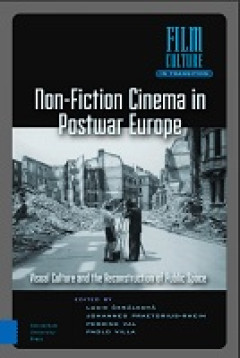Ditapis dengan

E-book Non-Fiction Cinema in Postwar Europe: Visual Culture and the Reconstru…
After WWII, cinema was everywhere: in movie theatres, public squares, factories, schools, trial courts, trains, museums, and political meetings. Seen today, documentaries and newsreels, as well as the amateur production, show the kaleidoscopic portrait of a changing Europe. How did these cinematic images contribute to shaping the new societies emerging from the ashes of war, both in the Western…
- Edisi
- -
- ISBN/ISSN
- 9789048556625
- Deskripsi Fisik
- 520 halaman
- Judul Seri
- -
- No. Panggil
- 778.534 CES n
E-book Upon Entropy : Architectonics of the Image in the Age of Information
In computerized societies, Lyotard w rites, knowledge ceases to have an end in itself and starts to be produced in order to be sold and consumed. Exchange becomes its ultimate goal: the introduc-tion of the computer and information technology defines not only a society but a condition at large and a stage of progress in which knowledge turns into a commodity. According to Lyotard, such a con…
- Edisi
- -
- ISBN/ISSN
- 9783035627695
- Deskripsi Fisik
- 256 hlm
- Judul Seri
- -
- No. Panggil
- 720.1 VIL u
E-book Ung Uro : Unsettling Climates in Nordic Art, Architecture and Design
On the outskirts of Oslo, there is a clearing in the woods. The tall trees that once grew here were felled in 2014, leaving a sharp border between the dark forest and the open space [figure 1]. In this clearing, a new gener-ation of Norwegian spruce is growing. The young trees are marked by red ribbons and, after growing for a hundred years, these trees will be felled, transformed into paper, a…
- Edisi
- -
- ISBN/ISSN
- 9788202712341
- Deskripsi Fisik
- 157 hlm
- Judul Seri
- -
- No. Panggil
- 701 HAL u
 Karya Umum
Karya Umum  Filsafat
Filsafat  Agama
Agama  Ilmu-ilmu Sosial
Ilmu-ilmu Sosial  Bahasa
Bahasa  Ilmu-ilmu Murni
Ilmu-ilmu Murni  Ilmu-ilmu Terapan
Ilmu-ilmu Terapan  Kesenian, Hiburan, dan Olahraga
Kesenian, Hiburan, dan Olahraga  Kesusastraan
Kesusastraan  Geografi dan Sejarah
Geografi dan Sejarah